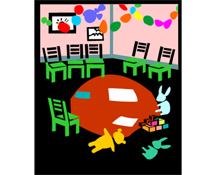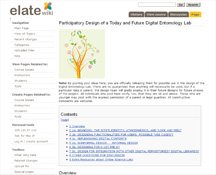2. More Ambitious (Far-Out) Design Questions
Setup of the Questions
Directions: The following mobile-friendly activity summarizes the differences between formal, non-formal, and informal learning.
Formal Learning: The original Digital Entomology Lab was created to complement an online course. It was part of formal learning, with assignments designed for learners to use in a specific way. Formal learning is intentional and built around learning objectives, and it is often directed and focused. The default position in this design was setting up this lab for formal learning. Formal learning often involves the formal earning of learning credit.
Non-Formal Learning: By contrast, non-formal learning stems from intentional learner-based life activities. This learning does not lead to any formal certification, but it does lead to the acquisition of new knowledge and skill sets. the learners here may be amateurs--individuals who are acquiring nonformal expertise and who may not have any ambitions to achieve professional-level skills. Or they may be novices, beginning learners who have just discovered an early-level interest in a particular topic; they are sampling the field non-formally to see if there is further interest in a more formal pursuit of learning in that domain field. Some non-formal learners may involve those who are starting informal insect collections. Others may want to "type" a particular unknown insect by comparing images between the sample insect and those captured in the digital imagery.
Informal Learning: Or they may be Informal learning refers to often-unintentional happenstance learning that happens as a byproduct of daily activities. A visitor to this online digital laboratory may want to learn about particular types of insects that have been found in a particular region of the world. Or he / she may be looking for close-up imagery of certain insect parts that have unique design functions.
Differentiating between Formal, Non-Formal, and Informal Learning
Directions: The following sorting activity provides scenarios to be sorted into various categories of types of learning. Click on the card pile to turn over the card, and then drag it to the proper pile.
Those who want to see an early conceptualization of how these various types of use cases may apply to the site may view an image at this link. Please do not view this until after you have contributed your design ideas.
---
A Different Age Group of Users: The needs of learners at different developmental stages will differ. How may their varying levels of needs be considered? What information would they need that others may not?
---
Strategic Partnerships? Is it possible to meld particular types of digital (or analog) information for value-added learning?
---
|
|
2a. Nonformal Design ... Informal Design
|
|
|
2b. Designing for K-12? Pre-K?
|
|
|
2c. Design for Integration with Other Digital Repositories? Digital Libraries?
|
An Invitation to a Virtual Participatory Design "Party"
|
You're Cordially Invited!
To participate, please go to the following page: "Participatory Design of a Future Digital Entomology Lab (A Share Area)". Text, images, links to online videos, and other contents may be posted here in this open wiki structure. Please offer your own ideas, and please also respond to others' ideas.This area will be left open and publicly editable for the length of time that this article is live. (Anything posted on the wiki page will be released for possible use by the design team.) Your help with this project is deeply appreciated.
Note: By posting your ideas at the wiki site, you are officially releasing them for possible use in the design of the Digital Entomology Lab. There are no guarantees that anything will necessarily be used, but if a particular idea is salient, the design team will gladly employ it in their future designs for future phases of the project. This participatory design project may be written up for academic publication in a reputable academic publication. All individuals who post here verify, too, that they are 18 and above. Those who are younger may post with the express permission of a parent or legal guardian. All constructive comments are welcome.
(Thanks! Dr. Roger W. McHaney generously shared access to the ELATEwiki site for the interactive part of this project.)
|
NEXT: Move forward to see how the digital participatory design questions may be evaluated. The next page includes a suggested reading on digital labs for online learning and a brief conclusion. (Click "next page" below, or click the proper page number above.)






